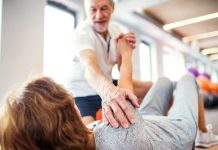
In a new study from McGill University and elsewhere, researchers found to prevent the spread of COVID-19 indoors, the two meters physical distancing guideline is not enough without masks.
However, wearing a mask indoors can reduce the contamination range of airborne particles by about 67%.
The team says mask mandates and good ventilation are critically important to curb the spread of more contagious strains of COVID-19, especially during the flu season and winter months as more people socialize indoors.
While most public health guidelines recommend physical distancing of two meters for people from different households, the researchers say distancing alone is not enough to prevent the spread of COVID-19.
In the study, they found that when people are unmasked, more than 70% of airborne particles pass the two meters threshold within 30 seconds. By contrast, less than 1% of particles cross the two-meter mark if masks are worn.
Building on models used by scientists to study the flow of liquids and gasses, the team developed a computer program to accurately simulate coughing dynamics in indoor spaces.
While ventilation, a person’s posture, and mask-wearing impacted the spread of the bio-contaminants significantly, the impact of age and gender was marginal, the researchers found.
Coughing is one of the main sources of the spread of airborne viruses from symptomatic individuals.
This study advances the understanding of how infectious particles can spread from a source to their surroundings and can help policymakers and governments make informed decisions about guidelines for masks and distancing in indoor settings.
If you care about COVID-19, please read studies about people with these blood types may have lower risk of severe COVID-19 and findings of this common blood thinner drug can help inhibit COVID-19 virus.
For more information about COVID-19 and your health, please see recent studies about COVID-19 vaccinations: What you need to know about the second dose and results showing that people with this bone problem twice as likely to die if they have COVID-19.
The study is published in Building and Environment. One author of the study is Saad Akhtar.
Copyright © 2021 Knowridge Science Report. All rights reserved.



